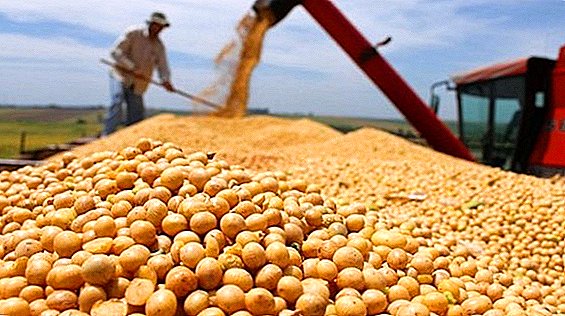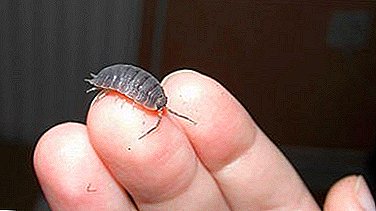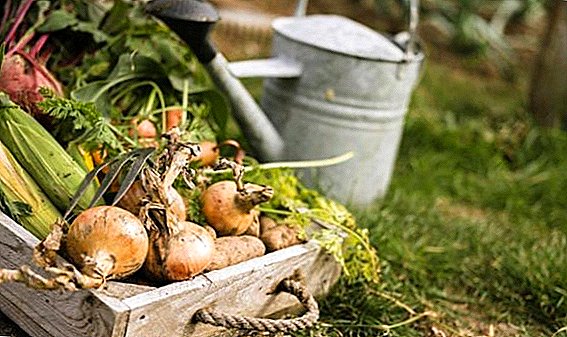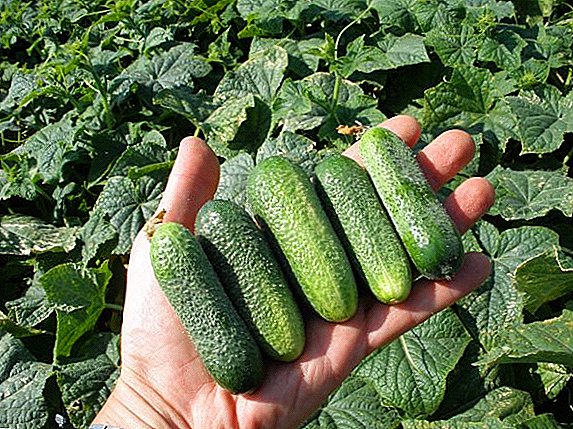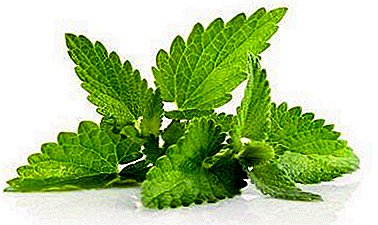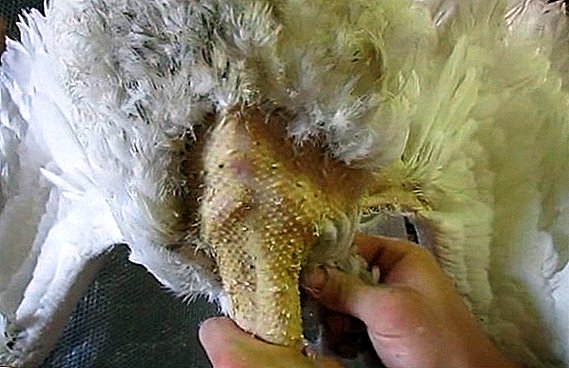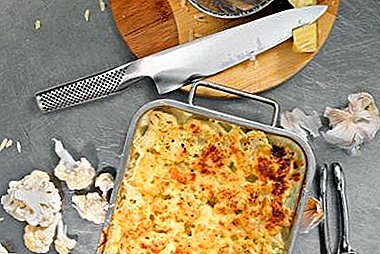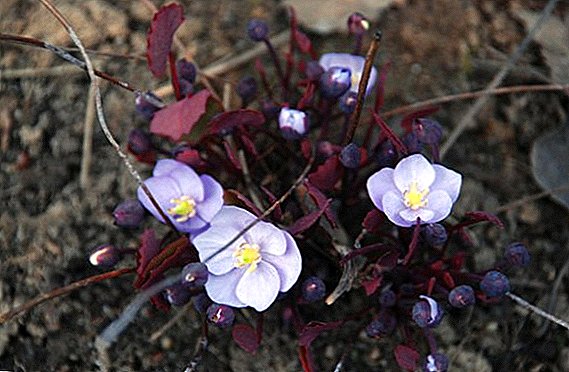 A well-kept garden is a charming place where you can relax with your body and soul. However, to grow beautiful and healthy plants is not so simple, and to create a flower arrangement in the garden is sometimes quite an impossible task. This article tells about the beautiful ornamental plant of jefferson dubious - how it looks, how to care for it and how to use it for medicinal purposes.
A well-kept garden is a charming place where you can relax with your body and soul. However, to grow beautiful and healthy plants is not so simple, and to create a flower arrangement in the garden is sometimes quite an impossible task. This article tells about the beautiful ornamental plant of jefferson dubious - how it looks, how to care for it and how to use it for medicinal purposes.
Botanical description
Jeffersonian doubtful - Perennial grass, which belongs to the Barberry family. Jeffersonium grows in the form of small spherical bushes up to 40 cm tall. Leaves and flowers sprout straight from the branched rhizome.
Did you know? Jeffersonia received this name in honor of Thomas Jefferson, the third US president. He was a connoisseur and expert on plants. Thanks to his efforts in 1801, the world's first botanical garden was opened.
Leaves grow in early spring; at first they are purple-red, changing their color with time. The adult leaf is round, about 5 cm in diameter, green in color with a brown border at the edges. It has a specific sign - a semicircular notch at the top. The leaves continue to grow after flowering, fading in late autumn.  Jeffersonium doubtful blooms around April for 2 weeks. Flowers grow on a straight pedicel, which is as tall as a leaf or slightly taller. They look like six-pointed stars, lilac-blue. In the diameter of 20-25 mm.
Jeffersonium doubtful blooms around April for 2 weeks. Flowers grow on a straight pedicel, which is as tall as a leaf or slightly taller. They look like six-pointed stars, lilac-blue. In the diameter of 20-25 mm.
The fruits of the plant are elongated boxes in which seeds ripen. Usually they hide under thick leaves.
Distribution and ecology
Jeffersonian dubious distributed in the Far East of Russia, bordering with him the northeastern regions of China, as well as partly in North Korea. It grows most often in mixed deciduous forests, sometimes in shrubs and meadows. It prefers loose soil rich in humus.
Chemical composition
The plant contains a large amount of berberine - an alkaloid, which has unique healing properties. It is 3-5% in rhizomes and 1.5% in leaves. Saponins and alkaloids are present in the roots, and only alkaloids are present in the leaves.
You will be useful to get acquainted with the most useful medicinal plants.
Also in the composition of this plant include:
- palmatin;
- phenol alkaloid;
- Coptisin;
- Warrenin;
- rumikaeruric acid.

Use in traditional medicine
Jeffersonian herbs and roots are used for medicinal purposes. Most often, on the basis of their cooked broths.
A decoction of rhizomes is used to treat infectious diseases, increase appetite, improve vision, and to wash the inflamed eyes.
Decoction of herbs - for the treatment of chronic gastritis.
Below are recipes for making decoctions.
Recipe number 1 - with gastritis with reduced secretion:
Pour 1 tablespoon of dried, chopped herbs into a glass of water, boil over low heat for 3 minutes, leave for at least an hour, then strain. Take 1/4 cup 3 times a day for 40 minutes before meals.
Important! Jeffersonium Dubious is not officially registered as a medicinal plant.
Recipe number 2 - in the treatment of infectious diseases:
In 0.5 liters of water, add 2 tablespoons of dried rhizome, cook for 1 hour. Take in a volume of 100 ml 4 times throughout the day.
Preparation of raw materials
The grass (aboveground part) is harvested in early autumn, the roots - in October-November, when the leaves die off. Since they are quite branched, they must be started to dig at a distance of 10-12 cm from the bush.  Rhizomes pruned, quickly washed and sorted out, removing dead parts.
Rhizomes pruned, quickly washed and sorted out, removing dead parts.
Then the raw material is dried in air, spreading out on a flat surface in a single layer.
Store in fabric bags in a well-ventilated area for no more than 2 years.
Important! Rinse the roots need a very short time, because the active substances of the plant dissolve well in water.
Application in gardening
Jeffersonia is a great garden plant, it is shade-loving and unpretentious to care, which is a big plus for gardening. As a rule, there are many shaded places in the garden, and most plants like sunny places. Therefore, jeffersonium has a significant advantage. However, do not forget about the intolerance of direct sunlight.
Today there are several varieties:
- Alba ("Alba") - flowers of white color with yellow stamens;
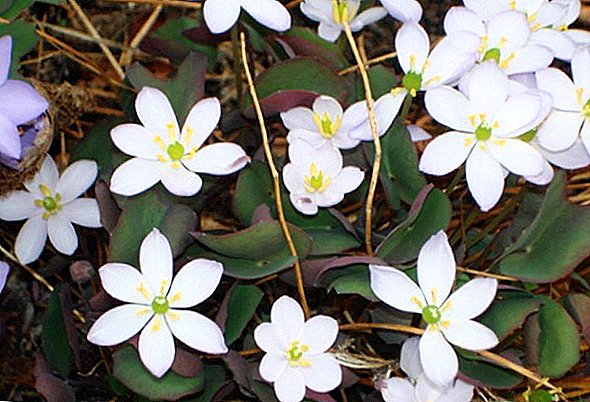
- Sunago-fu ("Sunago-fa") - lavender flowers with large silver-green leaves;
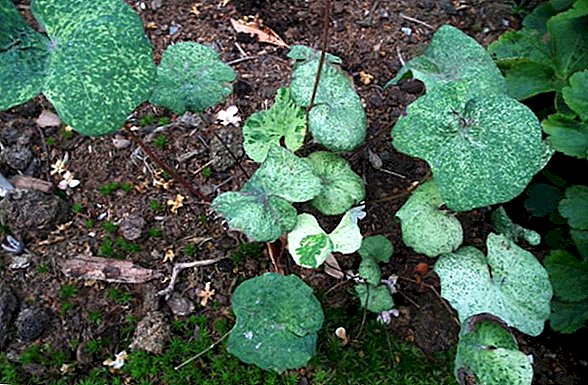
- Flore Pleno ("Flore Pleno") - flowers of terry form.

Bush slowly grows, can grow in one place for about 15 years.
Primrose goes well with stones. Good looking decorative stones of small and medium sizes in pinkish, blue shades. You can create a rock garden and plant these flowers in its most secluded corners.
It is necessary to take into account the small size of the jefferson when creating landscape compositions.
Growing and seeding at home
Jeffersonia is a perennial plant, it can grow in one place for more than 10 years under successful conditions for its development. Sometimes it multiplies by self-seeding, if it is in partial shade and it has enough water.
Planting and breeding
It is possible to propagate jeffersonia by such methods:
- division of the bush;
- planting seeds in the ground;
- planting seedlings in the ground.
Jeffersonian seeds do not have the property to be stored for a long time, so they need to be planted in the soil immediately after ripening - in July. Seed germination is quite low. Sprouted shoots consist of one leaf. The next year may bloom, but in most cases it occurs in 3-4 years.  Jeffersonian seeds doubtful A young plant must be watered from time to time.
Jeffersonian seeds doubtful A young plant must be watered from time to time.
Seed for seedlings at home
Seeds can be planted on seedlings - this should be done at the end of January. The ground should be slightly acidic, drainage holes are necessary in the container for planting. The seeds are laid out, not much pressing into the ground, then sprinkled a little earth. It is necessary to water moderately.
After the seeds germinate, you need to cover the container with polyethylene to create a greenhouse. It is necessary to dive after the appearance of the leaf on the saplings. Over time, they need to seed, and planted in the ground in late summer.
Seeds in the ground
To do this, choose a dark, damp place. Ripe seeds are put on the surface and slightly sprinkled on top of the compost. It is necessary to ensure that the earth does not dry out, regularly watering it.
We advise you to read how to make compost with your own hands and in garbage bags, as well as how to build a compost pit.
Dividing bush
Shrub dividing is the main breeding method for jeffersonian. Well-developed bushes are divided into 3-5 pieces, but not more. The division is ideally carried out in September, during the rains. It is necessary to land in small holes.
Soil and fertilizer
Grows well in loose, moist soil. When making fertilizer, it is not necessary to dig up the ground, the dressing needs to be scattered in a small amount near the bush.  Feed must be periodically from spring to autumn. Organic fertilizers are suitable: compost, humus, peat.
Feed must be periodically from spring to autumn. Organic fertilizers are suitable: compost, humus, peat.
Organic fertilizers also include: pigeon droppings, bone meal, fish meal, potato peel, egg shells, banana skins, onion peel, nettle and charcoal.
Watering and moisture
Watering is not necessary very often, but at such intervals that there is no drying out of the soil. The intensity of watering directly depends on the place where the bush grows: if it is in a dark, wet area, it is rare, otherwise it is much more often. Do not allow strong drying of the earth, especially in hot summer days.
Wintering and frost resistance
Jeffersonian leaves grow to frost. The plant tolerates frost well and tolerates winter without shelter. 
Diseases and pests
This plant is resistant to diseases, rarely plunges diseases and attacks of pests. But it is often the case that a fungal disease destroys planting, the risk of this is especially great when the soil is wet. Spores of fungi infect leaves and roots. For treatment, you can use "Fitosporin" or "Chistosad".
Slugs and snails can eat leaves. They plant on wet terrain. Pests can be collected by hand, usually they appear in small quantities.
Did you know? Jeffersonia received the specific epithet "doubtful" thanks to the indecisiveness of St. Petersburg scientists. For the first time this plant was described by Karl Maksimovich. When he presented his work to colleagues, the scientists, after long disputes, attributed Jefferson to the Barbaris family, but since some of the botanists did not agree with this decision, she was assigned the epithet “doubtful”.
So, jefferson is doubtful - an excellent plant for gardening. It is unpretentious and perfectly complement any floral arrangement of the garden. And in addition to the beautiful and original look, it will thank you for the care and its healing properties.





